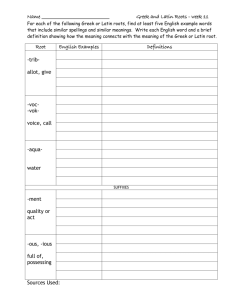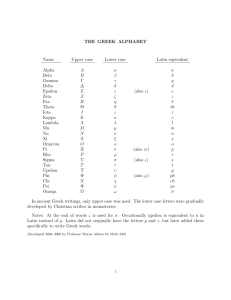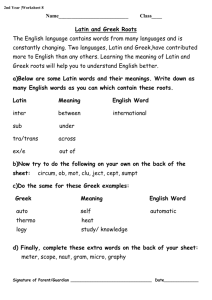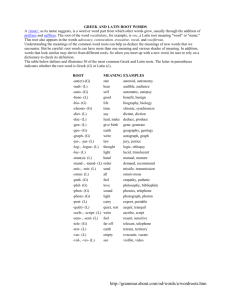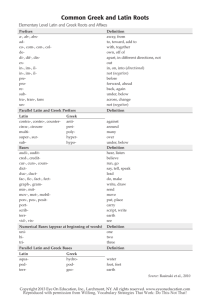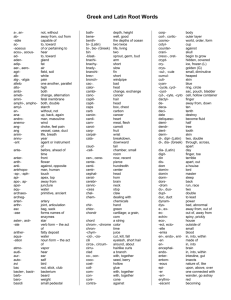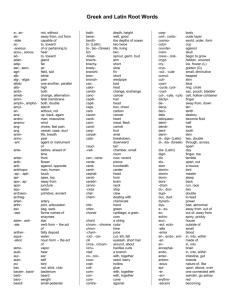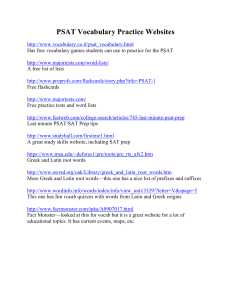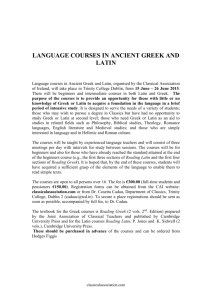Educator's Guide
advertisement
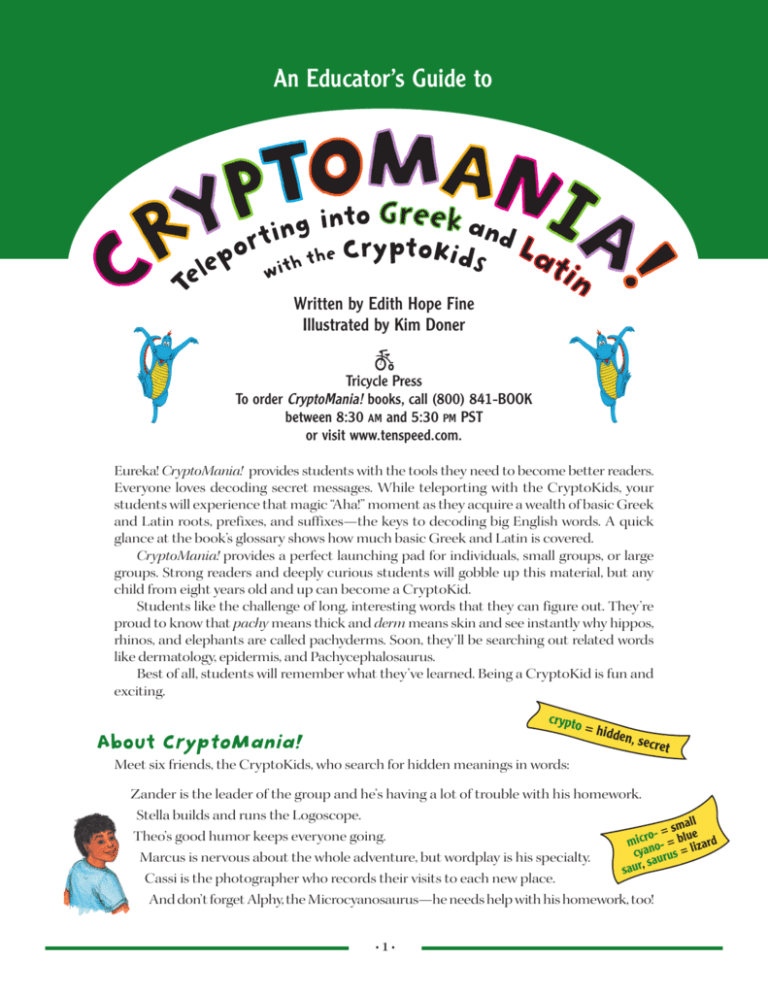
An Educator’s Guide to Written by Edith Hope Fine Illustrated by Kim Doner Tricycle Press To order CryptoMania! books, call (800) 841-BOOK between 8:30 AM and 5:30 PM PST or visit www.tenspeed.com. Eureka! CryptoMania! provides students with the tools they need to become better readers. Everyone loves decoding secret messages. While teleporting with the CryptoKids, your students will experience that magic “Aha!” moment as they acquire a wealth of basic Greek and Latin roots, prefixes, and suffixes—the keys to decoding big English words. A quick glance at the book’s glossary shows how much basic Greek and Latin is covered. CryptoMania! provides a perfect launching pad for individuals, small groups, or large groups. Strong readers and deeply curious students will gobble up this material, but any child from eight years old and up can become a CryptoKid. Students like the challenge of long, interesting words that they can figure out. They’re proud to know that pachy means thick and derm means skin and see instantly why hippos, rhinos, and elephants are called pachyderms. Soon, they’ll be searching out related words like dermatology, epidermis, and Pachycephalosaurus. Best of all, students will remember what they’ve learned. Being a CryptoKid is fun and exciting. crypto About CryptoMania! = hid den, s ecret Meet six friends, the CryptoKids, who search for hidden meanings in words: Zander is the leader of the group and he’s having a lot of trouble with his homework. Stella builds and runs the Logoscope. Theo’s good humor keeps everyone going. Marcus is nervous about the whole adventure, but wordplay is his specialty. Cassi is the photographer who records their visits to each new place. all = smlue o r c mi no- = b lizard cya urus = , sa u sa r And don’t forget Alphy, the Microcyanosaurus—he needs help with his homework, too! •1• The CryptoKids have a lot on their plate. • A huge vocabulary assignment, the “Mega-Word Opus,” is due Friday. • They should be planning a booth for their town’s centennial celebration on Saturday. • And now a mystery has landed in their laps. Looking at the book’s title page, where did Zander’s first prize package logo = w scop = ord come from? He never even entered a contest, but he’s received a package with look at a stuffed toy dinosaur and instructions to find the “key to new worlds,” plus a coded message about helping the blue dinosaur get home. Inspired by the Mega-Word Opus, Stella builds a “Logoscope”—a machine that will help the CryptoKids connect word parts (or “chunks”) and figure teleport = = far out big words. carry And, following the mysterious instructions, the CryptoKids key vis = a l c construct a “Teleporter” from a large box. They’re just playing with it until Alphy’s tail turns the magic key and they’re off! Together, the CryptoKids travel through time and space, picking up lots of Greek and Latin along the way to help complete their big assignment. They journey to: The Classical World Surf ’n’ Sky Alphasaurus Academy Mathopolis Terra Firma Polyphonic Philharmonic Tech Town Watch for Chee the squirrel and B.J. the blue jay; they add silly riddles, humor, and extra information throughout the book. Sometimes they’re hiding—can your students find them? The CryptoKids discover many kinds of keys before Zander realizes that he has misread the very first clue: Instead of the key to new worlds, they were supposed to search for the key to new words! Despite Zander’s mistake, all that teleporting and inadvertent learning helps the kids win first prize when they enter their Teleporter in the centennial booth contest. Oddly, in some of Cassi’s photos, seemingly random letters appear in green. At last, the CryptoKids realize the letters may be one last puzzle to figure out and Marcus unlocks the key to new words: CURIOSITY! The Set-up of the Book A lot of information is packed into this slim book. Here’s what to watch for. Yellow labels with wavy edges show Greek and Latin word chunks. Greek words are shown in green. (Greeks spoke ancient Greek.) Latin words are shown in red. (Romans spoke Latin.) •2• Light yellow boxes with rounded corners and shadows explain, clarify, and add details for you and your class to explore. Look for information on the Olympics, the binary number system, the night sky, and more. Each teleporter destination is featured on a double-page spread that artist Kim Doner has rendered in a unique style. A page with a black borders follows. Here, the CryptoKids are back in their Teleporter, using their Logoscope to create big new Greek- and Latin-based words. They think about where they just traveled, wrap up that adventure, add information about that topic, and read the clue to their next wild ride. Throughout, Zander appears next to lime green boxes, providing a running commentary and anchoring the story line. At the back of the book, you’ll find the Greek alphabet and two glossaries—one is English to Greek and Latin, and the other is Greek and Latin to English. Suffixes and numbers are listed last. Beyond the Book–Fun With Greek and Latin Teleporting into Greek and Latin roots is easy with CryptoMania! Here are three ways to create your own CryptoKids program. Ideas for Crypto projects follow. Organizing CryptoKids Programs The human brain loves to organize information. Young learners, as well as students in middle school and high school, pick up quickly on the Greek and Latin that the CryptoKids discover. Use CryptoMania! as a springboard to explore the roots of English words, whether it’s an informal approach, following children’s interests, or a planned program with children learning new Greek and Latin word parts each week. As parents, teachers, tutors, and home school instructors, you can use word chunks found in CryptoMania! with learners of all ages. You may be working one-on-one with a young reader or with small groups. Or you may be a classroom teacher, administrator, or PTA rep ready to help your whole school get involved. Anyone can become a CryptoKid. Go more slowly with emergent readers, younger readers, and ESL learners, respecting their individual learning styles. Use props, drawings, costumes, and zany acting skills to get the ideas across. Then follow up with plenty of light-hearted review. Provide good reference materials to help students dig for other English words related to word parts found in the book, then search out other roots, prefixes, and suffixes on their own. A dictionary that includes etymological information, such as The American Heritage Dictionary of the English Language is a must. (The new College Edition of the American Heritage does this.) One good book on roots is The Barnhart Concise Dictionary of Etymology by Robert K. Barnhart. Perhaps a local business would donate reference books like these to your school or organization. For more detailed information on running a CryptoKid program, visit www.CryptoKids.com. •3• Soaring into CryptoKid Projects CryptoMania! is loaded with ideas for fun activities. Send stories, drawings, photos of projects, and directions for new Crypto inventions to us at CryptoKids.com. ❑ Build a Logoscope Stella used boxes, scraps, and spare parts to build a Logoscope. Create a “working” Logoscope with your group. Make Greek and Latin word chunks enter the machine and whole words exit it. Use the Logoscope to explore Greek and Latin word parts beyond the CryptoMania! book. Can your students stump each other? ❑ Think of New Worlds for the CryptoKids Where else in the world (or out of this world!) could your kids and the CryptoKids travel? Invent new destinations with great Greek- or Latin- related names, and dig out related Greek and Latin word chunks to discover upon arrival. What will the CryptoKids be wearing? Who or what will they meet? Have your group write about their adventures and the Greek and Latin they pick up along the way. ❑ Travel by Teleporter Build an imagination-powered Teleporter (miniature or full-size), for traveling with the CryptoKids on further adventures through time and space. Add dials, clocks, buttons, levers, and viewing windows, and be sure to give it a name. ❑ Design Logomobiles Logomobiles are mobiles that have related words and/or pictures hanging from one primary Greek/Latin word chunk. See the sample Logomobiles in the book on pages 34 and 35. Use the Logoscope pages in CryptoMania! or the glossaries at the back of the book to track down other word chunks that lead to lots of English words. Create your own Logomobiles. (Suggestions for Logomobile starters are listed below with each destination.) ❑ Create-a-Critter Make up new Create-a-Critter wheels like the ones used at the Star Lake Centennial (page 35) and make wild, invented creatures (drawings, paintings, clay, papier maché, fabric, etc.) just by spinning the wheels. Is it a Bibliosaurus who chases after good books to read? A Septopod with seven springy pogo-stick legs? Ask kids to write about their critters. When did the creatures live? How much did they weigh? What did they eat? ❑ Play Around with Words Make up riddles, puns, and jokes with the Greek and Latin you learn. (See Mathopolis for math jokes.) All through the book, the CryptoKids hunt for the key to new worlds. How many keys do they discover? Have your kids look in a dictionary to find even more meanings of the word “key.” •4• ❑ Celebrate a Centennial The CryptoKids and all the residents of Star Lake celebrate the town’s hundred-year anniversary. Many schools celebrate the hundredth day of school. Make your hundred-day bash a CryptoMania! gala with the activities mentioned above. A fair, a skit, an all-arts day centered on art, literature, dance, and music . . . the possibilities are endless. Digging Deeper: Exploring the Teleporter Destinations Each of the Teleporter’s destinations is rich with material to explore. So are the Star Lake music rehearsal and the centennial celebration itself. Here are ideas to get you and your kids started. ❑ Classical Greece and Rome: Medicine and Science/Parts of the Body Dive into history: Learn about the Olympics and make time lines for Greek and Roman history. Learn about Plato and Socrates. Explore mythology: In Greek mythology, the chief god was called Zeus. The Romans called him Jupiter. Pair other Greek and Roman names of gods and goddesses. What were their roles? Where did they live? Find out about some of the myths. Tune up your geography: Make maps of ancient Greece and Rome. How far did the Roman Empire spread? What role did water and mountains play in its settlement? Find out more about the languages spoken then and now in Greece and Rome: Did you know that more than 60% of the words in the English language are derived from Latin? And when you see words with three or more syllables, 90% of them are derived from Latin? Knowing Greek and Latin basics will make your students great word detectives. To think about: What was it like to be a young person in ancient Greece or Rome? What games would you have played? Where would you have lived? What was the food like? What would your school have been like? Plan a feast featuring foods from these ancient civilizations. Logomobile starters: derm [G], pod [G], manu [L]. ❑ Alphasaurus Academy: The Age of Dinosaurs Our earth has changed over eons of time. What big shifts happened in the earth’s three long geologic ages: Paleozoic, Mesozoic, and Cenozoic? Dig for “fossils.” Bury several dinosaur models in sand or dirt. Like paleontologists, students make a grid with string marking out 12-inch squares. Students dig carefully with small trowels, then clean the finds with paint brushes, being careful not to disturb the “bones.” Make sketches before moving the “bones,” and write observational notes. Learn the divisions of the Mesozoic Era. Does “Jurrasic” ring a bell? Which dinosaurs lived when? Which were carnivores? Which were herbivores? •5• The Alphasaurus Academy has a silly thermometer on the wall. Here’s an experiment that’s really fun to do with your kids. You’ll need helium balloons with strings and play clay. Press enough clay around the string of a balloon to make the balloon hover right in front of your nose. Now start guiding the balloon slowly around the room without holding the string. You can tell where the room is warmer and where it’s cooler by watching your balloon. What’s happening with the temperature if the balloon goes higher? Lower? Move to different places in your home or school to observe different temperatures. Check results with a thermometer. Record your discoveries. Alphy’s classmates will give you some great ideas for doing your own Create-a-Critter activity. To think about: When your students’ parents were young, their dinosaur books had information that is different from today’s dino books. How can this be? What amazing discoveries have scientists made that give them new ideas about what dinosaurs looked like, where they lived, and how they moved er and behaved? When is a Brontosaurus not a Brontosaurus? thund = o t Don your Sherlock Holmes hat, grab your magnifying glass, bron and search out the true story behind this familiar dinosaur. Logomobile starters: saur [G], saurus [G], cerat- [G], cero [G], cornu [L]. ❑ Terra Firma: The Earth and the Sciences Cartographers make maps. What part of the world are Alphy and Zander looking at? Have kids map their school, their route home, or their room. Be sure they make a key to show what an inch on their map represents. Create word trails. Here’s an example: hippopotamus, Mesopotamia, mesoderm, dermotology, zoology, etc. Take a square foot field trip: Mark out a square foot in a garden, yard, beach, or field. Study what grows there, what insects or other animals visit, how the weather—sun, rain, wind—affects your square foot. Take field notes. Make sketches. Visit again in a month. How have things in the square foot changed? Set a timer and discover how fast kids can name the five layers of the atmosphere. To think about: Theo, Cassi, Stella, and Marcus are down on earth being scientists. Ask your kids what branch of science they might like to study if they were scientists. For instance, biology, the study of living things, has two main branches: zoology and botany. As entomologists they could study ant trails to see how a colony functions. As botanists, they could explore phototropism zo- = anim by planting sunflowers and finding out about = plants al us, botanikos ic n ta o b other phototropic plants. Logomobile starters: ge- [G], terra [L], scop [G], -ology, micro- [G]. •6• ❑ Tech Town: Cyberspace Students can turn a big box from an appliance store into a binary machine. A couple of students hide inside. Classroom visitors write an Arabic number on a card and put it into a slot on one side of the machine. Students inside the box quickly figure out the binary equivalent, write it down, and push this card out a slot on the other side. Sound effects add to the fun. Explore batteries and bulbs. Google “batteries and bulbs + elementary science” to find excellent units on electricity. Safety tip: Touch wires to batteries only briefly—they can get hot fast. The metric system includes many patterns. How many centimeters in a decimeter? How many decimeters in a meter? How many meters in a kilometer? Look for more metric patterns. Create a code. Try using letters, numbers, and symbols to send secret messages. In a simple code, A = 1, B = 2, C = 3, etc. Develop more complex codes and learn more about codes at the library. To think about: Have students interview their parents or grandparents to find out what the world was like before copiers, cell phones, computers, email, and the Internet. How has living in “Tech Town” changed our lives? Logomobile starters: re- [L], mega- [G], cycl- [G]. ❑ Surf ’n’ Sky: The Sea and Space Learn four constellations from the winter sky and four from the summer sky. Many are rooted in mythology—what’s the story behind them? Would friends in South America or New Zealand see the same night sky that your students do? Find out about latitude and longitude. What’s the exact location of your school? Mnemonics are handy memory aids. Examples are “HOMES” for the names of the five Great Lakes, and “Roy G. Biv” for the colors of the rainbow. Use Marcus’s mnemonic to name the nine planets in our solar system. Stump your students with this wild rhyme. What does it mean? Scintillate, scintillate, globule vivific, Fain would I fathom thy nature specific. Loftily poised on ether capacious, Strongly resembling a gem carbonaceous. •7• Sing “Twinkle, Twinkle, Little Star” all the way through in Latin. Mica, mica, parva stella, Miror quaenam sis tam bella. Super terra in caelo, Alba gemma splendido. Mica, mica, parva stella, Miror quaenam sis tam bella. The names of all our planets, except Earth, came from Roman mythology. Check out books to learn the stories. To think about: Why is the logo for the Seattle Mariners a compass rose? How does a compass rose work? Use a compass to find out which way is north, then paint a big compass rose on the playground. Make up a direction game. Can your students guess what this mnemonic stands for: NEWS (North, East, West, South). Logomobile starters: aqua [L], hydr [G], mar [L], nav [L], nau [L], naut [G], stella [L], astro- [G]. ❑ Mathopolis: Math Compare the flat shapes in the book with the 3-D ones. (Hint: Carla Cube and Sidney Square.) Create a 3-D rectangular gift box from a flat piece of paper or a manila folder. Make up more math jokes for the CryptoKids. Build geometric structures using toothpicks and dried peas that have been soaked in water to soften them. Which shapes are strongest? Be an engineer: Invent a way for a piece of paper placed on two paper cups to be strong enough to hold a small rock. Tell time with a clock that has Roman numerals for numbers. Create a Roman numeral machine (see page 34). Make it big (refrigerator box) or miniature (shoe box). Put Arabic numerals into the slot and make the Roman numeral equivalent come out the other side. Find out about the remarkable work of M.C. Escher, an artist who really knew how to work with shapes. Invent an “Escher” shape. (Click the links button at CryptoKids.com.) Put strings through straws to create triangles, then link the triangles to create structures. Find out about dome houses built by Buckminster Fuller. Why were they so strong? Who else might live in Mathopolis? Think up other citizens and animals. Look in used bookstores for a wonderful book called Building: The Fight Against Gravity by Mario Salvadori. As architects, your kids can build I-beams, uilder bridges, and other structures to explore math and architecture. tekton = b + f ie h c = archi •8• Remember: Always eschew sesquipedalianism! To think about: How many degrees in a circle? Use a protractor to draw circles and then divide them. Color these geometric designs with pencils or crayons. Logomobile starters: octo- [G], tri- [G], tri- [L], -meter [G], gon [G]. ❑ Polyphonic Philharmonic: Sound and Music Explore musical terms. Many—such as tremolo—come from Italian, but many others originated in Latin or Greek. Here’s a start: atonal, canon, cantata, dissonance, octet, pentatonic, quartet, quintet, resonance, triad, trio, unison. Learn about symphony instruments. You’ll find information online and from music education programs across the country. Using Greek and Latin roots, invent new instruments. Draw pictures; tell how they work. Make some real instruments and name them, using sound and music word chunks from Polyphonic Philharmonic. For instance, fill a row of glass cola bottles with different amounts of water and blow over the top to produce foghorn-like tones. Make percussion instruments using different kinds and sizes of wood blocks. Form a kazoo band to accompany a CryptoKid choir. Hold a CryptoKid concert with students dressed like Alphy’s classmates or citizens of Mathopolis. Compose a musical piece for Alphy to conduct. Add words for CryptoKids to sing about their adventures. Make a list of onomatopoetic words, from “sizzle” and “murmur” to “zap” and “swoosh.” Follow the trail of “son” words: Seattle SuperSonics, sonic boom, sonorous, sonnet, sonata, sonar, etc. To think about: How did the Sony company founders choose its name? Logomobile starters: phon [G], harmon- [G], audio [L], audit [L]. For more ideas, games, CryptoKid fun, and information on running a CryptoKids program at your school, visit www.CryptoKids.com. Send photos of your Crypto creations. We’ll post some on the Web site. •9•
